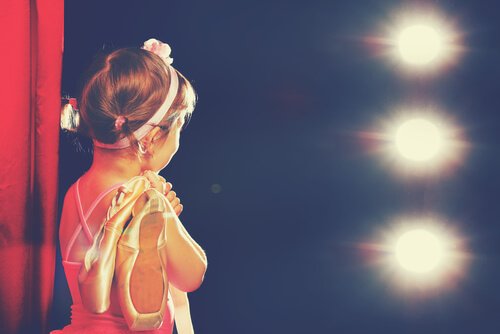The Benefits of Dramatic Arts for Children

Among the wide range of options available is that of dramatic arts, such as theater or acting classes.
In these classes, little ones develop their imagination and body language through games. Basically, the exercises are similar to those that children invent on their own while playing. However, in this case they’re guided and led by professionals.
These types of classes provide children with maximum benefits, all in the context of fun and play.
What do dramatic arts classes involve?
Children’s games are ideal instruments for exploring different abilities having to do with the body and expression – voices, attitudes and other abilities. For example, juggling or dancing. Children initiate play by imitating what they see or perceive in their surroundings.
Dramatic arts, in broad terms, follow this same logic. Classes stimulate creativity as well as a variety of social and cognitive abilities in children.
“Children’s games are ideal instruments for exploring different bodily expressions – voices, attitudes and abilities.”
In general, the exercises these classes tend to carry out explore a child’s ability to take on different roles or act as different characters. They also involve activities that have to do with oral and bodily expression, miming and movement.
Students must also imagine how their characters would react to certain situations, whether real or fantasy.

The benefits of the dramatic arts
“Thanks to drama classes, children are able to overcome their inhibitions. They show themselves to the world as they are, which allows them to gain self-confidence and self-assurance”
- Getting involved in the dramatic arts helps children to develop their verbal expression. This helps them to better communicate and also improves vocabulary, diction, fluidity, clarity, etc.
- These activities also improve bodily expression. Non-verbal communication is an important part of communication. This refers to body language – the messages we send through our gestures and movements. By studying dramatic arts, children become aware of their bodies and what they can transmit through them.
- Drama classes promote camaraderie and help children overcome shyness. The related activities tend to require teamwork with peers. Children learn to socialize, as well as the importance of respect and working with others.
- Dramatic activities help children understand and value consistency in their work. The goals of the dramatic arts aren’t immediate, rather they’re something that require time and dedication. Some children may experience frustration upon failing to see immediate results. However, if they persevere, they will come to see the fruits of their efforts.
- Children learn to connect with their emotions – identifying them and reflecting upon them. They put themselves in the shoes of others, be they fictional characters or real. This helps them understand different ways of seeing the world.
- Students also gain perspective, self-esteem, security and self-confidence upon comprehending what’s happening to them.
- The dramatic arts stimulate creativity and imagination, the best toys a child can have.
- These classes also transmit good values, such as equality, respect, commitment, responsibility, cooperation and being tolerant.
- All of this learning occurs through fun games and activities. It’s very important that children enjoy the activities that they are doing.
The importance of parental support
Parental support and encouragement are always fundamental. But when it comes to the dramatic arts, this support becomes even more important.
As children advance in their drama classes, they will develop new and varied abilities. Often they develop the desire to participate in projects that reflect all they have learned.

In most cases, this involves performing on a stage so that family and friends can appreciate their talent and efforts. These events usually require parental involvement to some degree or another.
For example, parents may need to make costumes, help build the set, or contribute with other material items.
However, these material items aren’t what’s most important. Besides constant support along the way, special performances will require the entire family to make an extra effort.
This can mean helping children to control their anxiety, going over lines, taking care of last-minute details, etc. But all of this hard work will have its rewards.
Children will feel satisfaction as they see their own progress and experience the support of their family members. At the same time, parents will delight in seeing their children shine and enjoy their time in the spotlight.
Among the wide range of options available is that of dramatic arts, such as theater or acting classes.
In these classes, little ones develop their imagination and body language through games. Basically, the exercises are similar to those that children invent on their own while playing. However, in this case they’re guided and led by professionals.
These types of classes provide children with maximum benefits, all in the context of fun and play.
What do dramatic arts classes involve?
Children’s games are ideal instruments for exploring different abilities having to do with the body and expression – voices, attitudes and other abilities. For example, juggling or dancing. Children initiate play by imitating what they see or perceive in their surroundings.
Dramatic arts, in broad terms, follow this same logic. Classes stimulate creativity as well as a variety of social and cognitive abilities in children.
“Children’s games are ideal instruments for exploring different bodily expressions – voices, attitudes and abilities.”
In general, the exercises these classes tend to carry out explore a child’s ability to take on different roles or act as different characters. They also involve activities that have to do with oral and bodily expression, miming and movement.
Students must also imagine how their characters would react to certain situations, whether real or fantasy.

The benefits of the dramatic arts
“Thanks to drama classes, children are able to overcome their inhibitions. They show themselves to the world as they are, which allows them to gain self-confidence and self-assurance”
- Getting involved in the dramatic arts helps children to develop their verbal expression. This helps them to better communicate and also improves vocabulary, diction, fluidity, clarity, etc.
- These activities also improve bodily expression. Non-verbal communication is an important part of communication. This refers to body language – the messages we send through our gestures and movements. By studying dramatic arts, children become aware of their bodies and what they can transmit through them.
- Drama classes promote camaraderie and help children overcome shyness. The related activities tend to require teamwork with peers. Children learn to socialize, as well as the importance of respect and working with others.
- Dramatic activities help children understand and value consistency in their work. The goals of the dramatic arts aren’t immediate, rather they’re something that require time and dedication. Some children may experience frustration upon failing to see immediate results. However, if they persevere, they will come to see the fruits of their efforts.
- Children learn to connect with their emotions – identifying them and reflecting upon them. They put themselves in the shoes of others, be they fictional characters or real. This helps them understand different ways of seeing the world.
- Students also gain perspective, self-esteem, security and self-confidence upon comprehending what’s happening to them.
- The dramatic arts stimulate creativity and imagination, the best toys a child can have.
- These classes also transmit good values, such as equality, respect, commitment, responsibility, cooperation and being tolerant.
- All of this learning occurs through fun games and activities. It’s very important that children enjoy the activities that they are doing.
The importance of parental support
Parental support and encouragement are always fundamental. But when it comes to the dramatic arts, this support becomes even more important.
As children advance in their drama classes, they will develop new and varied abilities. Often they develop the desire to participate in projects that reflect all they have learned.

In most cases, this involves performing on a stage so that family and friends can appreciate their talent and efforts. These events usually require parental involvement to some degree or another.
For example, parents may need to make costumes, help build the set, or contribute with other material items.
However, these material items aren’t what’s most important. Besides constant support along the way, special performances will require the entire family to make an extra effort.
This can mean helping children to control their anxiety, going over lines, taking care of last-minute details, etc. But all of this hard work will have its rewards.
Children will feel satisfaction as they see their own progress and experience the support of their family members. At the same time, parents will delight in seeing their children shine and enjoy their time in the spotlight.
All cited sources were thoroughly reviewed by our team to ensure their quality, reliability, currency, and validity. The bibliography of this article was considered reliable and of academic or scientific accuracy.
- Daste C.; Jenger, Y. y Voluzan, J. (1978). El niño, el teatro y la escuela. Madrid: Villalar.
- Eines, J. y Mantovani, A. (1997). Didáctica de la Dramatización. Barcelona: Gedisa.
- Navarro Solano, M. (2007). Drama, creatividad y aprendizaje vivencial: algunas aportaciones del drama a la educación emocional. Cuestiones pedagógicas, 18, 163-174. https://idus.us.es/xmlui/bitstream/handle/11441/12845/file_1.pdf?sequence=1
- Núñez Cubero, L. y Romero, C. (2004). La educación emocional a través del lenguaje dramático. Addenda a la II Ponencia: Los lenguajes de las Artes. Escenas y Escenarios en Educación, XXII-Site-Sitges Conference.
- Núñez Cubero, L.; Bisquerra Alzina, R.; González Monteagudo, J. y Gutiérrez Moar, M.C.(2006). Emociones y educación: una perspectiva pedagógica. En J.M. Asensio; J. Carrasco García; L. Núñez Cubero y J. Larrosa (Coords.) La vida emocional. Las emociones y la formación de la identidad humana (171-196). Barcelona: Ariel.
- Tejerina, I. (1994). Dramatización y teatro infantil. Dimensiones psicopedagógicas y expresivas. Madrid: Siglo XXI.
- Vieites, M. F. (2017). La Pedagogía Teatral como Ciencia de la Educación Teatral. (UVIGO). Universidad de Vigo. Pontevedra. España. Revista Educaçao & Realidade, Porto Alegre 42 (4): 1421-1544. Recuperado de http://www.scielo.br/pdf/edreal/v42n4/2175-6236-edreal-62918.pdf
- Laferriere, G. (1999). 11 La pedagogía teatral, una herramienta para educar. Educación social, 1, 55. Recuperado de https://core.ac.uk/download/pdf/39108274.pdf
This text is provided for informational purposes only and does not replace consultation with a professional. If in doubt, consult your specialist.








